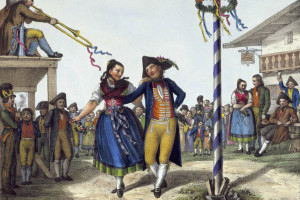WSJ Historically Speaking: The Many Meanings of May Day
The Law of Non-‐Contradiction states that it isn’t possible to be both Y and Not-‐Y at the same time—which suggests that the law never encountered May Day, the public holiday celebrated on May 1, which both is and isn’t a celebration of summer. May Day owes its origins to the ancient festivals—from the Roman Floralia to the Celtic Beltane—that celebrated the first plantings of the season and the coming of the solstice.
May Day owes its origins to the ancient festivals—from the Roman Floralia to the Celtic Beltane—that celebrated the first plantings of the season and the coming of the solstice.
By the end of the Middle Ages, the day had become one of the most important on the calendar. Just as the fir tree has become a popular symbol of Christmas, the flowering hawthorn—also called the May tree—became the sacred emblem of summer. (When Shakespeare wrote, “Rough winds do shake the darling buds of May” in his famous Sonnet 18, he meant the tree, not the month.)
On May Day, people danced, sang and partied around maypoles with bacchanalian abandon. Such ungodly behavior appalled the early Puritan colonists, who banned maypoles from Massachusetts. Their brethren in the British Parliament followed suit in 1644, declaring them “a heathenish vanity, generally abused to superstition and wickedness.” But the Puritans’ war on May Day ultimately came to nothing: Dancing around the maypole resumed after Charles II, known as the “merry monarch,” returned from exile in 1660.
In America, however, the campaign against May Day enjoyed more success. Respectable folk either ignored the holiday or marked it only in small ways, such as exchanging flower baskets. Gradually, May Day’s disreputable aura made it a natural outlet for social protest. By the 19th century, the link was indissoluble. In 1867, Chicagoans fighting for a standard eight-hour workday deliberately chose May 1 to launch their general strike.
Karl Marx’s “Das Kapital,” published the same year, helped to spread the eight-hour movement around the world. As workers’ protests grew, the nascent U.S. labor movement held its first national strike on May Day 1886. The largest demonstrations took place in Chicago, which culminated in the Haymarket Riot on May 4, leaving at least 11 people dead and scores injured.
President Grover Cleveland quickly took steps to dissociate May Day from the labor movement, giving in to its request for a public holiday while ensuring that Labor Day was held in the more politically neutral month of September. But what seemed like a canny move at the time essentially handed May Day to the communists. In 1889, the Second International Socialist Congress renamed May 1 “International Workers’ Day” and declared it an annual day of protest. During the Russian Revolution, the Bolsheviks were particularly adept at using May Day as a weapon.
Alarmed by the growing number of May Day riots in the U.S., anticommunist groups began to fight back. One of the earliest salvos in what has been dubbed the “Red Scare” involved redesignating May Day during World War I as “Americanization Day”; it became “Loyalty Day” in the 1920s. For good measure, Congress added “Child Health Day” to May 1 in 1928. During the second Red Scare after World War II, President Dwight Eisenhowerdecided that the message had become muddled. He made Loyalty Day an official holiday and moved Child Health Day to October. Since 1959, every U.S. president has issued an annual Loyalty Day proclamation.
But despite a centurieslong propaganda campaign to control the meaning of May Day, the holiday remains as contested as ever. Whether deciding between maypoles, may-baskets or mass action, it turns out that humans are stubborn, contradictory creatures who don’t mind a little illogic in their lives.

